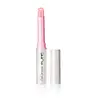What's inside
What's inside
 Key Ingredients
Key Ingredients

 Benefits
Benefits

 Concerns
Concerns

 Ingredients Side-by-side
Ingredients Side-by-side

Octyldodecanol
EmollientRicinus Communis Seed Oil
MaskingBis-Diglyceryl Polyacyladipate-2
EmollientPentaerythrityl Tetracaprylate/Tetracaprate
EmollientPentaerythrityl Tetraisostearate
EmollientCera Microcristallina
Emulsion StabilisingCaprylic/Capric Triglyceride
MaskingPolyethylene
AbrasiveParaffin
PerfumingEthylhexyl Methoxycinnamate
UV AbsorberCopernicia Cerifera Cera
EmollientHelianthus Annuus Seed Cera
EmollientButylene Glycol
HumectantButyl Methoxydibenzoylmethane
UV AbsorberShorea Robusta Resin
TonicParfum
MaskingRhus Verniciflua Peel Cera
EmollientPanthenol
Skin ConditioningPropylparaben
PreservativeCanola Oil
EmollientRosa Canina Fruit Oil
EmollientBHT
AntioxidantTocopherol
AntioxidantAscorbyl Palmitate
AntioxidantCitric Acid
BufferingOctyldodecanol, Ricinus Communis Seed Oil, Bis-Diglyceryl Polyacyladipate-2, Pentaerythrityl Tetracaprylate/Tetracaprate, Pentaerythrityl Tetraisostearate, Cera Microcristallina, Caprylic/Capric Triglyceride, Polyethylene, Paraffin, Ethylhexyl Methoxycinnamate, Copernicia Cerifera Cera, Helianthus Annuus Seed Cera, Butylene Glycol, Butyl Methoxydibenzoylmethane, Shorea Robusta Resin, Parfum, Rhus Verniciflua Peel Cera, Panthenol, Propylparaben, Canola Oil, Rosa Canina Fruit Oil, BHT, Tocopherol, Ascorbyl Palmitate, Citric Acid
Hydrogenated Polyisobutene
EmollientIsononyl Isononanoate
EmollientEthylene/Propylene/Styrene Copolymer
Diisostearyl Malate
EmollientPolybutene
Hydrogenated Polyisobutene, Isononyl Isononanoate, Ethylene/Propylene/Styrene Copolymer, Diisostearyl Malate, Polybutene, Aroma, BHT, Butylene/Ethylene/Styrene Copolymer, Cocos Nucifera Oil, Hydroxymethoxyphenyl Propylmethylmethoxybenzofuran, Pentaerythrityl Tetra-Di-T-Butyl Hydroxyhydrocinnamate, Tocopherol, Tocopheryl Acetate
 Reviews
Reviews

Ingredients Explained
These ingredients are found in both products.
Ingredients higher up in an ingredient list are typically present in a larger amount.
BHT is a synthetic antioxidant and preservative.
As an antioxidant, it helps your body fight off free-radicals. Free-radicals are molecules that may damage your skin cells.
As a preservative, it is used to stabilize products and prevent them from degrading. Specifically, BHT prevents degradation from oxidation.
The concerns related to BHT come from oral studies; this ingredient is currently allowed for use by both the FDA and EU.
However, it was recently restricted for use in the UK as of April 2024.
Learn more about BHTTocopherol (also known as Vitamin E) is a common antioxidant used to help protect the skin from free-radicals and strengthen the skin barrier. It's also fat soluble - this means our skin is great at absorbing it.
Vitamin E also helps keep your natural skin lipids healthy. Your lipid skin barrier naturally consists of lipids, ceramides, and fatty acids. Vitamin E offers extra protection for your skin’s lipid barrier, keeping your skin healthy and nourished.
Another benefit is a bit of UV protection. Vitamin E helps reduce the damage caused by UVB rays. (It should not replace your sunscreen). Combining it with Vitamin C can decrease sunburned cells and hyperpigmentation after UV exposure.
You might have noticed Vitamin E + C often paired together. This is because it is great at stabilizing Vitamin C. Using the two together helps increase the effectiveness of both ingredients.
There are often claims that Vitamin E can reduce/prevent scarring, but these claims haven't been confirmed by scientific research.
Learn more about Tocopherol